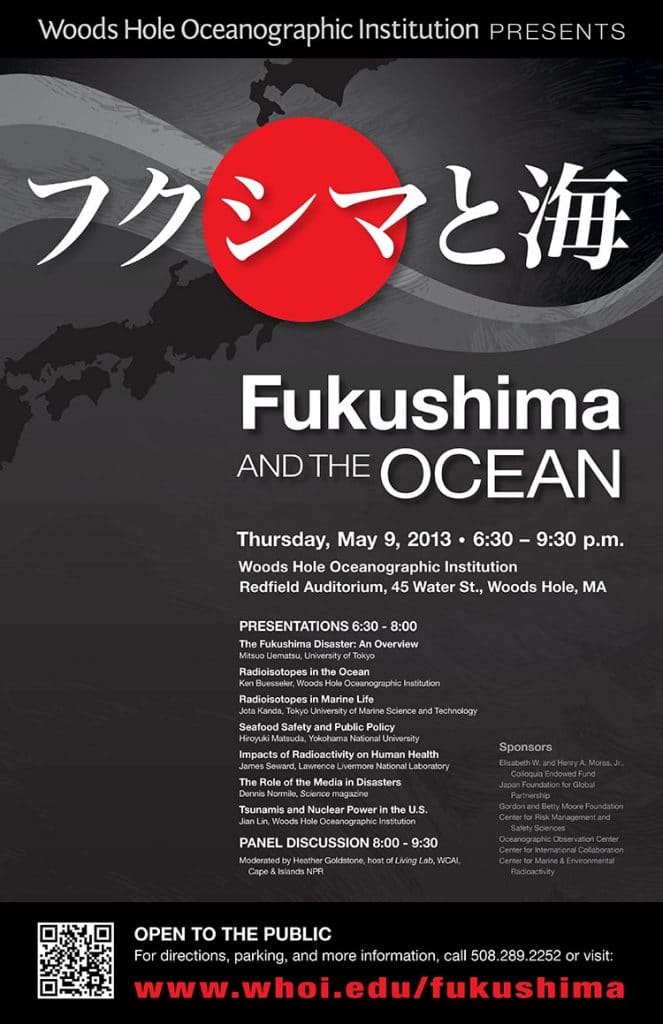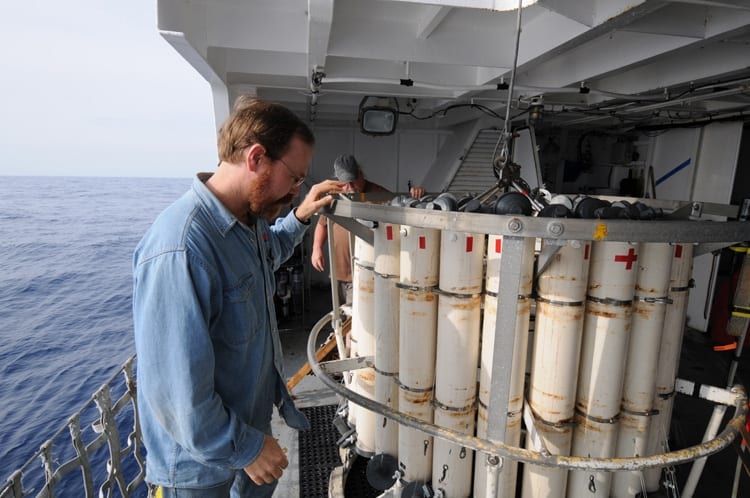WHOI to Host Public Event on Fukushima and the Ocean
April 29, 2013
Japan’s “triple disaster,” as it has become known, began on March 11, 2011, with a magnitude 9.0 earthquake—the fourth largest ever recorded. Following the quake, a 40 to 50-foot tsunami inundated the northeast Japanese coast and resulted in an estimated 20,000 missing or dead. The massive wave also caused catastrophic damage to the Fukushima Dai-ichi nuclear power plant.
The release of radioactivity from Fukushima—both as atmospheric fallout and direct discharges to the ocean—represent the largest accidental release of radiation to the ocean in history. More than two years after the disaster, some Japanese coastal fisheries remain closed. Questions and concerns over continued radioactive water leaks from the plant remain as well.
The Woods Hole Oceanographic Institution (WHOI) will host a free, public forum exploring the impact of Fukushima on the ocean and human health on May 9, 2013, from 6:30 to 9:30 p.m. in Redfield Auditorium, 45 Water Street, Woods Hole.
Presentations and a panel discussion will examine natural and human sources of radiation in the ocean, what was released from Fukushima, impacts on marine ecosystems and human health, public policy implications, and how information is communicated to the public.
“The goal is not to alarm or assign blame, but to talk about lessons learned from this tragic event,” said WHOI senior scientist and marine chemist Ken Buesseler, who led the first international, multidisciplinary assessment of the levels and dispersion of radioactive substances in the Pacific Ocean off the Fukushima nuclear power plant in June 2011.
Due to space limits, attendees are encouraged to go on line to reserve their seat (www.whoi.edu/fukushima), which will be held until 10 minutes before the start of the event. Those unable to attend can view the presentations live via online simulcast or access an archived version on line after the event (www.whoi.edu/fukushima).
The program will feature short keynote presentations by:
Mitsuo Uematsu, University of Tokyo
“The Fukushima Disaster: An Overview”
Ken Buesseler, Woods Hole Oceanographic Institution
“Radioisotopes in the Ocean”
Jota Kanda,Tokyo University of Marine Science and Technology
“Radioisotopes in Marine Life”
Hiroyuki Matsuda, Yokohama National University
“Seafood Safety and Public Policy”
James Seward, Lawrence Livermore National Laboratory
“Impacts of Radioactivity on Human Health”
Dennis Normile, Science Magazine
“The Role of the Media in Disasters”
Jian Lin, Woods Hole Oceanographic Institution
“Tsunamis and nuclear power in the U.S.”
Following the presentations, Heather Goldstone, host of Living Lab on WCAI, the Cape and Islands NPR station, will moderate a panel discussion from 8 p.m. to 9:30 p.m.
The program is part of the Woods Hole Oceanographic Institution’s Morss Colloquia series, established thanks to a generous gift by Elisabeth W. and Henry A. Morss, Jr.
Additional sponsors for this program include the Japan Foundation Center for Global Partnership, Gordon and Betty Moore Foundation, Center for Risk Management and Safety Sciences at YNU, Oceanographic Observation Center at TUMST, Center for International Collaboration at AORI, International Union of Radioecology, and Center for Marine and Environmental Radioactivity at WHOI.
The Woods Hole Oceanographic Institution is a private, non-profit organization on Cape Cod, Mass., dedicated to marine research, engineering, and higher education. Established in 1930 on a recommendation from the National Academy of Sciences, its primary mission is to understand the oceans and their interaction with the Earth as a whole, and to communicate a basic understanding of the oceans’ role in the changing global environment.


